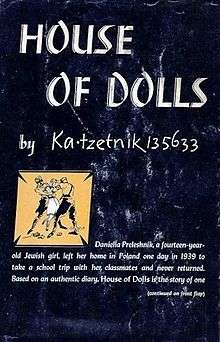House of Dolls
 First English-language edition | |
| Author | Ka-tzetnik 135633 |
|---|---|
| Translator | Moshe M. Kohn |
| Country | Israel |
| Language | English translation from the original Hebrew |
| Publisher | Simon & Schuster (first English edition) |
Publication date | 1955 |
| Media type | Print (Hardback & Paperback) |
House of Dolls is a 1955 novella by Ka-tzetnik 135633. The novella describes "Joy Divisions", which were groups of Jewish women in the concentration camps during World War II who were kept for the sexual pleasure of Nazi soldiers.
Origins
The origin of Ka-tzetnik's story is not clear. Some say it is based on a diary kept by a young Jewish girl who was captured in Poland when she was fourteen years old and forced into sexual slavery in a Nazi labour camp. However, the diary itself has not been located or verified to exist. Others claim, and the author suggests as much in his later book Shivitti, that it is based on the actual history of Ka-tzetnik's younger sister (House of Dolls is about the sister of Ka-tzetnik's protagonist, Harry Preleshnik).
Between 1942 and 1945, Auschwitz and nine other Nazi concentration camps contained camp brothels (Freudenabteilung "Joy Division"), mainly used to reward cooperative non-Jewish inmates.[1][2] Not only prostitutes were forced to work there. In the documentary film Memory of the Camps, a project supervised by the British Ministry of Information and the American Office of War Information during the summer of 1945, camera crews filmed women who had been forced into sexual slavery for the use of guards and favoured prisoners. The film-makers stated that as the women died they were replaced by women from the concentration camp Ravensbrück.[3]
Literature and scholarly references
In his essay "Narrative Perspectives on Holocaust Literature", Leon Yudkin uses House of Dolls as one of his key examples of the ways in which authors have approached the Holocaust, using the work as an example of "diaries (testimonies) that look like novels" due to its reliance on its author's own experiences.[4]
Ronit Lentin discusses House of Dolls in her work Israel and the Daughters of the Shoah. In her book Lentin interviews a child of Holocaust survivors, who recalls House of Dolls as one of her first exposures to the Holocaust. Lentin notes that the "explicit, painful" story made a huge impact when published and states that "many children of holocaust survivors who write would agree . . . that House of Dolls represents violence and sexuality in a manner which borders on the pornographic".[5]
Na'ama Shik, researching at Yad Vashem, the principal Jewish organization for the remembrance of the victims of the Holocaust, considers the book as fiction.[6] Nonetheless it is part of the Israeli high school curriculum.
The success of the book showed there was a market for Nazi exploitation popular literature, known in Israel as Stalags. However Yechiel Szeintuch from the Hebrew University rejects links between the smutty Stalags on one hand and on the other Ka-Tzetnik's works which he insists were based on reality.[6]
Popular culture
Joy Division was a British post-punk band from 1976 to 1980, who took their name from the reference in this book. One of their early songs, "No Love Lost", contains a short excerpt from the novella.
Love Camp 7 (1968), considered to be the first Nazi exploitation film, is set in a concentration camp "Joy Division".
See also
- Allied war crimes during World War II
- British war crimes
- Comfort women
- German camp brothels in World War II
- German military brothels in World War II
- German war crimes
- Japanese war crimes
- Rape during the occupation of Germany
- Recreation and Amusement Association
- Sexual slavery
- Soviet war crimes
- United States war crimes
References
- ↑ New Exhibition Documents Forced Prostitution in Concentration Camps Spiegel Online, 15 January 2007
- ↑ Auschwitz, inside the Nazi state: Corruption, PBS. Accessed 28 April 2007.
- ↑ Memory of the Camps, Frontline, PBS
- ↑ Yudkin, Leon; various co-authors (1993). "Narrative Perspectives on Holocaust Literature". In Leon Yudkin, ed. Hebrew Literature in the Wake of the Holocaust. Fairleigh Dickinson University Press. pp. 13–32. ISBN 0-8386-3499-0.
- ↑ Lentin, Ronit (2000). Israel and the Daughters of the Shoah: Reoccupying the Territories of Silence. Berghahn Books. pp. 33–34, 66 n. 4. ISBN 1-57181-775-1.
- 1 2 Israel’s Unexpected Spinoff From a Holocaust Trial, Isabel Kershner, New York Times, September 6, 2007
Further reading
- Ka-tzetnik 135633. The House of Dolls. ISBN 1-85958-506-X.
- Wyden, Peter. Stella: One Woman's True Tale of Evil, Betrayal, and Survival in Hitler's Germany. ISBN 0-385-47179-3.
- Full text in English at Archive.org